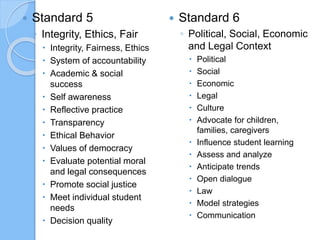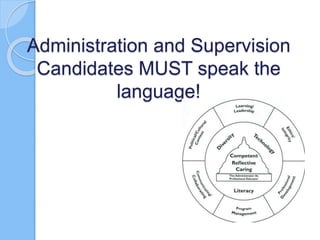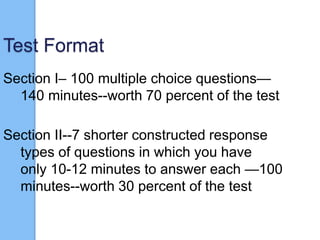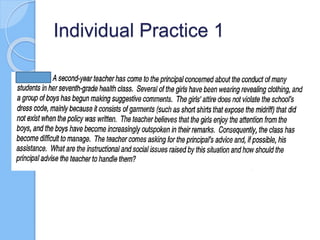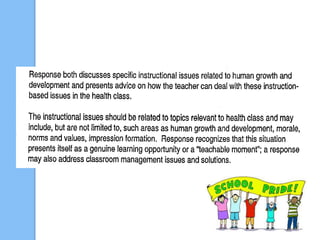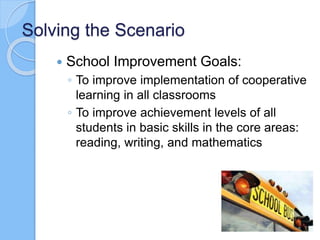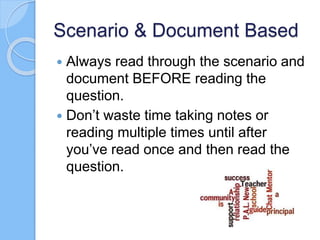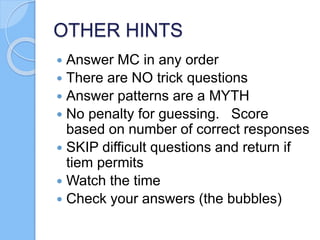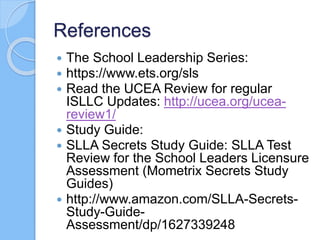School Leaders Licensure Assessment Review: From This Book: SLLA Crash Course (2017)
- 1. SLLA REVIEW SESSION School Leaders Licensure Assessment Preparation Wafa Hozien, Ph.D. Education Administration whozien@vsu.edu Virginia State University
- 2. Getting Started Jigsaw Activity: In groups of two: Brainstorm key terms associated with the standard assigned to your group.
- 3. ISLLC Standards Standard 1: Setting a widely shared vision for learning Standard 2: Developing a school culture and instructional program conducive to student learning and staff professional growth Standard 3: Ensuring effective management of the organization, operation, and resources for a safe, efficient, and effective learning environment Standard 4: Collaborating with faculty and community members, responding to diverse community interests and needs, and mobilizing community resources Standard 5: Acting with integrity, fairness, and in an ethical manner Standard 6: Understanding, responding to, and influencing the political, social, legal, and cultural contexts
- 4. STANDARD 1: ◦ Vision of Learning Facilitation Challenges Strategic Planning Leadership Capacity Stakeholder Involvement Collaborative Develop & Implement Collect data Assess effectiveness Promote learning Continuous & Sustainable improvement Monitor & Evaluate Modeling the vision STANDARD 2: ◦ Instructional Leadership Culture Instructional Program Student Learning Professional Growth Climate Nurture & Sustain High Expectation Comprehensive, Rigorous Motivating learning env. Supervision Assessment & Accountability systems Monitor progress Leadership capacity Quality Instruction Technologies Change
- 5. Standard 3 ◦ School Operations Coordinating Organizing Planning Resource acquisition & management Ensure safety Monitor, evaluate management & operations Obtain, allocate, utilize Promote and protect Distributive leadership Support quality instruction Consensus building Quality Personnel Standard 4 ◦ School Community Relations Diversity Assess interests and needs Utilize community resources Collaboration Collect and analyze data Promote understanding, appreciation of diversity Build and sustain positive relationships Build and sustain productive relationships Emerging issues and trends Involve stakeholders School decision-making process Visibility Value Diversity
- 6. Standard 5 ◦ Integrity, Ethics, Fair Integrity, Fairness, Ethics System of accountability Academic & social success Self awareness Reflective practice Transparency Ethical Behavior Values of democracy Evaluate potential moral and legal consequences Promote social justice Meet individual student needs Decision quality Standard 6 ◦ Political, Social, Economic and Legal Context Political Social Economic Legal Culture Advocate for children, families, caregivers Influence student learning Assess and analyze Anticipate trends Open dialogue Law Model strategies Communication
- 7. Administration and Supervision Candidates MUST speak the language!
- 8. Test Format Section I– 100 multiple choice questions— 140 minutes--worth 70 percent of the test Section II--7 shorter constructed response types of questions in which you have only 10-12 minutes to answer each —100 minutes--worth 30 percent of the test
- 9. Test Format – Revolves Around ISLLC Standards Vision and goals—20 % of exam., 18MC, 2 CR Teaching and learning—30% of exam., 25 MC, 3 CR Managing organizational systems and safety— 10% of exam., 15 MC, O CR Collaboration with Key Stakeholders—15% of exam, 21 MC, 0 CR Ethics and Integrity—15% of exam, 21 MC, 0 CR The Educational System—10% of exam, 0 MC, 2 CR
- 10. Preparing for SLLA Practice in dealing with problems in a quick, yet effective manner (connected to what you have learned in classes and noted from ISLLC standards) is the best approach in preparing for the test Use the ETS resource book available online
- 11. Preparing for the exam: Know the STANDARDS but no need to memorize, but have a great understanding of the descriptors related to each (activity we did earlier) Think about the type of school leader identified in the Standards and prepare to respond to test questions in a Standards- relevant way Be aware of the amount of time allocated for each section
- 12. Continued Preparation of SLLA Sample Questions and Scoring Criteria— study sample questions and scoring guides Make sure responses demonstrate a sufficient breadth and depth of knowledge To get the highest score—ANSWER ALL PARTS OF THE QUESTION
- 13. Constructed Response Key to successfully answering the Constructed Response test questions is to focus on the key words in the ISLLC Standards Review all the CR questions and select the easiest ones for you…and do those first Read the complete CR and any supporting documents Mentally think through your solution to the problem (as you would in real-life)
- 14. Constructed Response Pace yourself—Watch your watch—10 minutes per question with time at the end to go back and review Plan, write and review Answer each question in the space provided—writing in the margins or other incorrect locations could allow the item to not be scored correctly Review your responses—go back and evaluate for content, organization, clarity, and accuracy…answer ALL questions
- 16. Response Specifically addresses Professional Development/Training Issues Recognizes difficulty of change or fear of risks (ingrained practices) Teachers playing it safe for evaluation observations Belief that cooperative learning doesn’t work for certain students Difficulty implementing cooperative learning because of classroom management issues.
- 17. SAMPLE : Question 1 The leader of a middle school instructional team comes to the principal, concerned that she is shouldering most of the burden of coordinating the instructional team’s planning for instruction. She feels increasingly resentful and angry at her team members. The principal expresses understanding of the teacher’s situation and, to help relieve the burden on her, appoints a new team leader . Do you agree with the principal’s action? Give a rationale citing factors that are relevant to a principal’s decisions in such situations.
- 18. 1- Response includes SPECIFIC reference to at least one of the following ◦ the principal’s need to acquire more information about the situation before acting ◦ the principal’s leadership includes assisting the team leader to succeed in the role and to enable the team to function well, or ◦ a concern for team process and the involvement of stakeholders in making decisions, the importance of consensus building and conflict resolution ◦ 0—Response is vague, omits reference to any of the essential factors, or evaluates the principal’s action without qualification
- 19. Question 2 A parent requests that her child be retained in first grade. Although the child missed two weeks of school due to chicken pox, the teacher believes that the child is intellectually, socially, and physically ready for second grade. The principal observes the child for one hour and concurs with her experienced teacher’s recommendation that the child be promoted to second grade. The principal decides that he must deny the parents request. Do you agree with this action? Give rationale, citing factors that are relevant to a principal’s decisions in such situations.
- 20. Scoring Guide Response specifically cites the principal’s need to acquire more information about the situation, plus one of the following: ◦ Parents have information and insights about the child that the school would not have ◦ Part of the responsibility of school leadership is share information with the parents about the possible consequences of retention.
- 21. Question 3 It is early December and the students in an elementary school are practicing for the annual holiday concert. A parent phones the school to insist that her child not be required to sing any of the Christmas songs. The principal excuses the child from participation in the music practice. Do you agree with the principal’s action? Give a rationale, citing factors that are relevant to a principal’s decisions in such situations
- 23. Question 4 The technology committee of a high school recommends the purchase of graphing calculators for the mathematics department. After checking with three vendors, the principal decides to authorize a contract to purchase them from the wife of a faculty member since she is able to offer a good price and will be readily available for help with instruction and for service. What are the issues raised by this decision?
- 27. Solve this Scenario You are the newly assigned principal of James Madison School, an elementary school with an excellent reputation in the area, enriched programs in all grades, and high level of parent participation. The district has embarked on a major initiative in cooperative learning. By and large, the school has experienced rapid growth as a result of extensive real estate development in the area. One change evident in the past five years is that a much smaller proportion of the student population now participates in lessons, classes, sports activities, and other educational and personal opportunities outside the scope of the school.
- 28. Solving the Scenario School Improvement Goals: ◦ To improve implementation of cooperative learning in all classrooms ◦ To improve achievement levels of all students in basic skills in the core areas: reading, writing, and mathematics
- 29. Solving This Scenario Questions: 1. Based on your understanding of learning and teaching and larger educational issues, identify and describe the broader challenges faced by the school. 2. Evaluate the given school improvement plan in terms of its strengths and weaknesses. Describe the actions the principal should take to implement the plan and elicit community support.
- 30. Scoring Rubric Well developed analysis and synthesis of all documents Describe challenges faced by the school Evaluation of Improvement Plan (strengths and weaknesses) Multiple ways to elicit community support Multiple actions principal should take
- 31. Multiple Choice Which of the following ◦ Answer fits in “Which of the following” Circle or underline critical details Read the entire question Read all of the responses
- 32. Multiple Choice: Not, Least, Except Select the choice that DOESN’T fit Used when there are several good answers, but also clearly wrong way Always capitalized…pay attention
- 33. Scenario & Document Based Always read through the scenario and document BEFORE reading the question. Don’t waste time taking notes or reading multiple times until after you’ve read once and then read the question.
- 34. OTHER HINTS Answer MC in any order There are NO trick questions Answer patterns are a MYTH No penalty for guessing. Score based on number of correct responses SKIP difficult questions and return if tiem permits Watch the time Check your answers (the bubbles)
- 35. Group Practice Multiple Choice Constructed Responses Student taking a break from Studying at University of Richmond.
- 36. References The School Leadership Series: https://www.ets.org/sls Read the UCEA Review for regular ISLLC Updates: http://ucea.org/ucea- review1/ Study Guide: SLLA Secrets Study Guide: SLLA Test Review for the School Leaders Licensure Assessment (Mometrix Secrets Study Guides) http://www.amazon.com/SLLA-Secrets- Study-Guide- Assessment/dp/1627339248
Editor's Notes
- Facilitator: Assign each group of two one standard. Have them brainstorm on a blank sheet of paper words associated with the standard.






